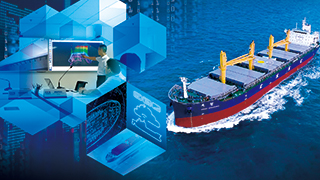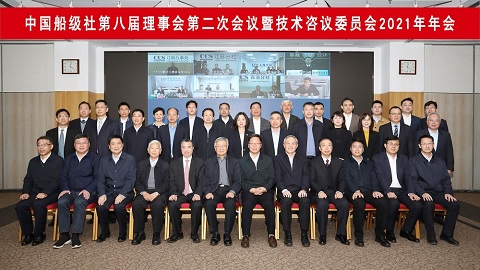On May 20, 2022, the world's first 100,000DWT smart fishery large-scale aquaculture vessel built by CSSC Qingdao Beihai Shipbuilding Co., Ltd. for CONSON CSSC (Qingdao) Ocean Technology Co., Ltd. and surveyed by China Classification Society (CCS) Qingdao Branch was successfully delivered.
By CCS Qingdao Branch

On May 20, 2022, the world's first 100,000DWT smart fishery large-scale aquaculture vessel built by CSSC Qingdao Beihai Shipbuilding Co., Ltd. for CONSON CSSC (Qingdao) Ocean Technology Co., Ltd. and surveyed by China Classification Society (CCS) Qingdao Branch was successfully delivered.
LU JI YU YANG 60616 was researched and developed under the leadership of the Fishery Machinery and Instrument Research Institute under Chinese Academy of Fishery Sciences. The vessel has a total length of 249.9 meters, a moulded breadth of 45 meters, a deadweight about 100,000 tons, a displacement of 130,000 tons and a designed speed of 10 knots. With twin-engine and dual-propeller electric propulsion, it has an endurance of 20,000 nautical miles and a self-supportability of 90 days. For fish farming, processing, transfer storage and experimental research, feed rooms, processing rooms, transfer vehicles, offshore cranes and refrigerated containers are provided on the main deck of the vessel. Besides, a helicopter landing platform and a hovering area are set by the feeders on the upper floor for easy ship-to-shore dispatching. Additionally, a breeding and scientific laboratory, a breeding monitoring room, and a breeding centralized control room are arranged in the upper structure.
LU JI YU YANG 60616, the world's first closed smart deep-sea aquaculture platform facility, is equipped with an integrated fishery service and production system of green farming, deep sea fishing, catch storage and replenishment based on a large cruising type ship-borne platform, creating a fishery production chain model combining "breeding-storing- supplement-adding" and "sea-island-land".
Its main equipment and functions include:
Aquatic water exchange system: purify the aquatic water by discharging wastewater in the cabin outboard through the drainage column in the aquaculture cabin.
Oxygenation system in aquaculture cabin: rapidly increase the oxygenation of seawater source water by oxygen cone equipment and the gas-water mixing method, so as to improve and maintain the dissolved oxygen concentration in the water in the aquaculture cabin, and to ensure the health and rapid growth of high-density breeding objects.
Emergency oxygenation system: When the aquaculture water exchange system or oxygen cone equipment fails to work, put the emergency aeration device into the aquaculture cabin for oxygen supply by the jet aeration method.
Feeding system: Bale pluckers, automatic bale breakers and feed conveyors are arranged in the feeding cabin, which can automatically feed the feeding system.
Adult fish catching system: catch the fish by lowering the net to gather fish and synergistically operating the fish-pump.
Fishhold lighting system: LED energy-saving lighting lamps are used to provide lighting for the fish and water environment in the breeding cabin, and serve as a light source supplement to the underwater video monitoring system.

Water quality monitoring system: conduct real-time online detection, display, alarm and recording of water quality indicators such as aquaculture water temperature, PH value, dissolved oxygen concentration, and salinity.
Aquaculture video monitoring system: carry out the real-time monitoring of the interior of the aquaculture cabin and underwater breeding objects, and send video images to the display in the centralized aquaculture control room and the network cloud platform in real time.
On-board processing system: provide frozen and chilled processing for the caught fish.
Centralized aquaculture control system: serve as the centralized control station of the aquaculture system in the ship.
Dead fish recovery system: The center of the fish tank is designed with a funnel-shaped sewage collection and discharge structure. The dead fish are gathered into the funnel with the water flow under the action of their own gravity, and then sucked out regularly by the fish-pump of the adult fish catching system.
During the survey of the ship, CCS Qingdao Branch started by straightening out the survey process of the aquaculture vessel type, consulted and studied a large number of technical data of aquaculture equipment from the point of survey requirements of aquaculture equipment and its relationship with ship safety and environmental protection requirements, and thus formed the advantages of survey technology of such vessels. At the completion stage, a technical summary of such vessels was established, and the CCS's survey guidelines for aquaculture equipment were compiled, which could guide CCS's survey of such vessels in the future.

It is worth mentioning that LU JI YU YANG 60616 successfully completed the trial voyage on International Labor Day. As Qingdao Branch attached great importance to this Deputy General Manager of the Branch, was participated in the trial voyage that was coordinated and directed by Wang Hai, the Deputy Director of the Shipbuilding Department.
While coordinating the shipyard for all relevant tests, the trial voyage team also discussed the type improvement of subsequent ships with the shipowner and the shipyard. Meanwhile, a series of suggestions on ship type optimization (including that of aquaculture facility), construction difficulties and risk mitigation, as well as construction cost reduction and optimized layout of aquaculture facilities, were put forward for subsequent ship types, which were highly recognized by the shipowner and shipyard.
During the trial voyage, the team worked hand in hand with the shipowner and the shipyard to address the difficulties. After 6 days of high-intensity work in a row, the trial voyage was successfully completed, providing CCS with valuable experience for the construction of subsequent ships.
The successful delivery of the ship contributes to the construction of a new model of deep-sea industrialized green aquaculture and expands new space for fishery development, further driving China's marine aquaculture industry to go deep blue.
Note: If you need to reprint, please indicate the source of the information.













